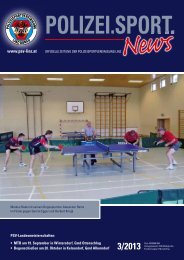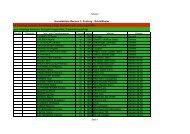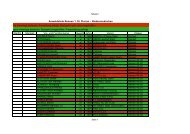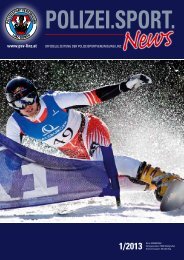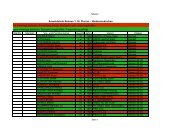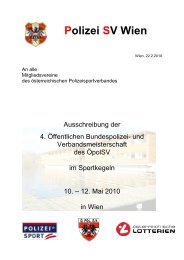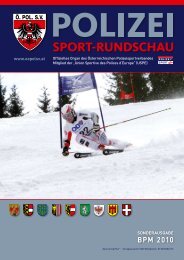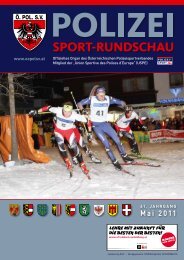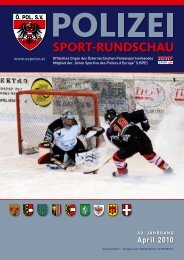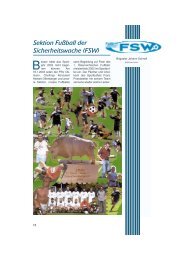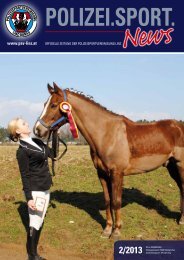PSN-03 - psv - linz
PSN-03 - psv - linz
PSN-03 - psv - linz
Erfolgreiche ePaper selbst erstellen
Machen Sie aus Ihren PDF Publikationen ein blätterbares Flipbook mit unserer einzigartigen Google optimierten e-Paper Software.
magazin<br />
Therefore these courses will provide the<br />
participants first-hand knowledge of how<br />
and when to employ Bloodstain Pattern<br />
Analysis and/or searching and enhancement<br />
techniques to locate and visualize<br />
latent bloodstains. Participants will acquire<br />
first-hand knowledge of the benefits<br />
as well as the limitations of Bloodstain<br />
Pattern Analysis our commonly utilized<br />
chemical searching and enhancement<br />
techniques.<br />
Martin Eversdijk<br />
René Gelderman<br />
Basic Bloodstain Pattern<br />
Analysis course<br />
(40 Hours)<br />
Our 5 day (40 hours) Basic Bloodstain<br />
Pattern Analysis Course is designed to give<br />
the participants a basic foundation on<br />
Bloodstain Pattern Analysis. The focus<br />
of this intensive course is to provide the<br />
participants knowledge of Bloodstain Pattern<br />
Analysis through the application of<br />
concepts of biology, biochemistry, physics<br />
and mathematics to objectively define and<br />
reconstruct events associated in a bloodletting<br />
event. This training will give participants<br />
a unique opportunity to acquire<br />
first-hand knowledge of the bloodstain<br />
pattern analysis through lectures of theory,<br />
demonstrations and hand-on practical<br />
laboratory exercises.<br />
This course is designed for all levels of law<br />
enforcement personnel, especially those<br />
who search for blood at scenes as well as<br />
on articles of physical evidence, investigators,<br />
crime scene personnel, attorneys,<br />
prosecutors, judges, medico legal investigators<br />
and participants studying forensics<br />
science and/or criminal justice.<br />
This 40 hour basic course follows the<br />
recommended training guideline as set<br />
forth by the Scientific Working Group<br />
for Bloodstain Pattern Analysis (SWGS-<br />
TAIN) and the International Association<br />
of Bloodstain Pattern Analysis (IABPA).<br />
Training topics to be covered:<br />
• History of Bloodstain Pattern Analysis.<br />
• Characteristics of Liquid Blood.<br />
• Flight characteristicts of blood and their<br />
patterns.<br />
• Target Surface Considerations.<br />
• Impact Angle Determination.<br />
• Calculating the Area of Origin.<br />
• Limitations of bloodstain pattern analysis.<br />
• Sampling techniques and presumptive<br />
testing.<br />
• Interpretation with the use of the<br />
SWGSTAIN taxonomy.<br />
• Proper documentation and photographing<br />
of bloodstains.<br />
• Approaching a bloodstain pattern case.<br />
• Using bloodstain patterns to reconstruct<br />
crime scenes.<br />
• Case reviews.<br />
• Health and Safety Issues.<br />
• Bloodstain analysis equipment.<br />
Pre-Requisites: None.<br />
What to bring to the course:<br />
Participants are advised to bring seasonally<br />
appropriate clothing.<br />
We also encourage to bring a digital camera<br />
which could be very helpful if you<br />
wish to document any of your<br />
experiments.<br />
Assessment Standards/Certification:<br />
A certificate will be issued for successful<br />
completion of a written assessment of the<br />
course requirements.<br />
Materials/Supplies Loci Forensics<br />
B.V. will provide:<br />
• Laboratory and Reference Manual.<br />
92



